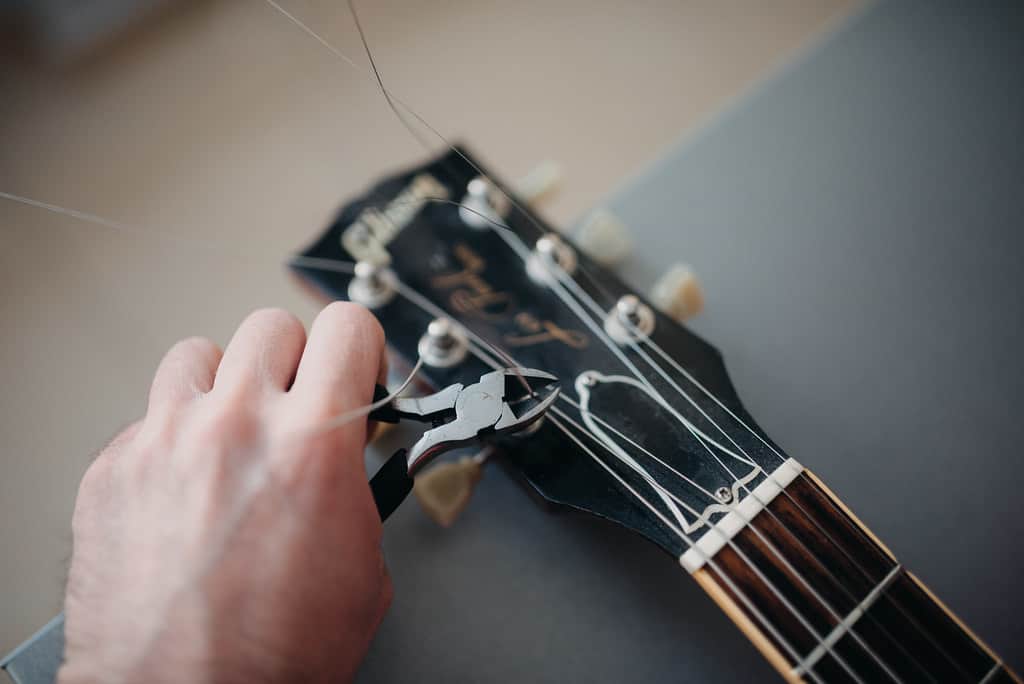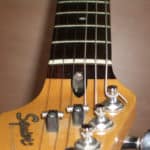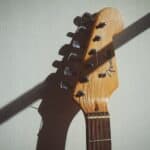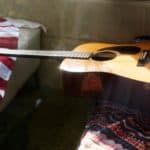The guitar is often portrayed as a very delicate instrument and while in a lot of cases it is definitely something that should be handled with care, it’s important to not overestimate its fragility.
Actually, guitars are probably tougher than you think.
There are many myths surrounding everything related to string tension and how it interacts with the neck of the instrument.
So, if you are wondering if taking all strings of a guitar could damage it, here is a short answer:
Simply taking the strings off a guitar won’t damage it unless something extreme follows or precedes the string coming off. Gutiar necks are designed to counterbalance the tension strings exert on them, but contrary to popular belief, taking that tension off will not affect them in any permanent way.
There can be various scenarios in which the strings of a guitar may need to come off and I will look into all of those in this article.
Are you ready to get started?
Let’s go!
Would leaving my guitar without a string damage it?
In very arbitrary terms, the guitar is all about balancing tension.
Under normal operating conditions, the strings exert tension in one direction.
This tension is counteracted by the neck of the guitar which is essentially a composite material made out of wood and a metallic truss rod.
There is a popular misconception that if the tension provided by the strings was not present, the neck would deform under its own tension.
This is, however, not true.
While the neck will become straighter without the strings, this isn’t a permanent situation and the neck will adjust properly once the strings are put back on again.
If the guitar is left without strings for a very long time, there might be some minor issues but these aren’t permanent either.
It will take a bit more effort to get the guitar back to playing shape but that is not just down to the strings not being there.
If a guitar is left unattended for a long time, it will need some setup work irrespective of whether it has strings or not.
Are there any risks in doing this?
Generally, there are no risks.
The neck itself regardless of whether it is a set-neck or a bolt-on neck is very strong structurally.
So, if you are worried that the neck will snap back or crack when the strings come off, you can rest easy.
The neck does flex or bend in the direction the strings pull but this movement is not something to worry about.
Even if all the strings were to snap all at once, the neck won’t snap back with any noticeable force. This means that it is safe for both you and the guitar.
It is worth noting that in guitars with a floating bridge or a loose nut, even if one string snaps, the guitar will have to be re-tuned and it could possibly need some setup work.
Should I remove all strings at once when restringing?
This is another scenario where the guitar won’t suffer in any way.
Many guitarists will often snap all the strings off together prior to restringing.
However, prior to this, ensure that the strings are loosened.
This is because a string can snap back with considerable force and they do so at a very rapid pace.
This can cause injury to anyone near the guitar especially if the sharp end of the snapped string finds its way into an eye.
Ideally, detune all the strings until they are just wobbling around and then remove the strings one at a time.
Avoid the use of scissors or a snipper as they can send the string flying around in an uncontrolled manner.
Why do many players think removing strings could be harmful?
It all comes down to perception and a few misconceptions about the structural design of a guitar.
The guitar and the strings are under a lot of tension and this tension can be felt when tuning the guitar.
It is natural to assume that if all this tension was to be released all at once, something catastrophic could happen to the guitar.
However, this is not the case.
The truss rod in the guitar neck is very robust and steady and in combination with the wood used to make the neck, it adjusts to a sudden release in tension in a very gradual manner.
A guitar neck flexes by very small margins even under full load which means that when this tension is removed all of a sudden, the neck will move back only by a very small margin which does not present any real risk.
What should I do if my guitar neck bends after I remove the strings?
As alluded to earlier, the guitar neck will become straighter when the strings are removed.
In almost every case, this is a temporary situation.
Fixing this is actually very easy as all you have to do is restring the guitar.
Keep in mind that strings will also stretch during the first few days, so you might have to tune the guitar multiple times during this time period.
Even after this if the neck is bent, which will result in either fret buzz or an action that is too high, then adjust the truss rod.
Don’t overdo this though.
Turn the truss rod a quarter of a turn at a time and give it some time to settle and see if the issue is fixed.
The truss rod should be tightened (turned clockwise) if the string action is too high and the neck needs to be straightened.
On the other hand, the truss rod should be loosened (tuned anti-clockwise) if there is fret buzz.
The recommended method for restringing your guitar
The best way to restring a guitar is by doing it gradually.
- Take off the strings one at a time. After all the strings have been removed, let the guitar settle for a few minutes and then start restringing.
- On standard tuning, start with the D-string. Tune it halfway through and then do the same with the A-string.
- This is followed by the low E-string and then the high E-string.
- The G-string goes next and finally the B-string. For other tunings, start with the middle string followed by the highest and lowest strings and then add the remaining strings.
- Once all the strings have been tuned halfway through, follow the same order and tune each string to the correct key.
You might have to keep tuning each string a few more times but eventually, all the strings will be in tune.

Hello there, my name is Ramiro and I’ve been playing guitar for almost 20 years. I’m obsessed with everything gear-related and I thought it might be worth sharing it. From guitars, pedals, amps, and synths to studio gear and production tips, I hope you find what I post here useful, and I’ll try my best to keep it entertaining also.





